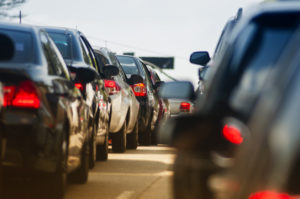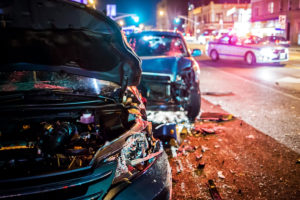
Multi-vehicle collisions are often deadly, and the person who caused the accident should be held responsible for their negligent actions. If you or a loved one were injured in a pileup crash, call a Macon chain reaction accident attorney at (478) 310-2290 now. We’ll fight to get you the compensation you need.
Causes of Pileup Crashes
Most multi-vehicle collisions occur when a driver crashes into the back of another car, sending that car forward into the next, and so on. Most of the time, the initial collision is caused by distracted driving, which includes:
- texting
- changing the radio station
- and daydreaming
But not all chain reaction accidents follow that pattern. An experienced Macon car accident lawyer will investigate the crash and determine which party is responsible for your injuries and property damage. Here are some of the other causes of chain reaction, or pileup accidents.
Not Driving Safely in Bad Weather
In poor weather conditions like dense fog, heavy rain, and snow, visibility is significantly limited, calling for drivers to exercise extreme caution on the road. For example, in heavy rain, it’s best to turn your headlights on, slow down, and avoid switching lanes. Most people use common sense while driving in bad weather, but some don’t.
Some people drive their cars just as aggressively as they would in perfect conditions, speeding or following too closely. These are dangerous behaviors that can easily turn deadly when one car collides with another. If that car is unable to stop or regain control, it may end up causing a pileup.
Speeding
Even in perfect weather, drivers who speed are in danger of losing control of their vehicle, increasing the risk of a pileup accident. Also, speeding drivers don’t have time to slow down or brake if they notice a crash in front of them. The original crash may have involved two cars, but the addition of a speeding vehicle can easily cause more vehicles to collide.
Drowsy Driving or Falling Asleep
Drowsy driving is more than just feeling a little tired behind the wheel. It’s extremely dangerous and can cause different types of accidents, including chain reaction crashes. Tired drivers don’t have the same judgment skills or reaction times as alert drivers, so getting behind the wheel or continuing to drive when you’re tired is a disaster waiting to happen.
Many drowsy driving cases involve semi-trucks. Some trucking companies encourage employees to drive past the federally mandated 12-hour limit, a dangerous practice that puts countless people directly in harm’s way.
Tailgating
A driver doesn’t have to be speeding to cause a chain reaction crash. All it takes is following another vehicle too closely. Not giving safe distance drastically reduces a driver’s ability to slow down, increasing the chance that they rear-end the vehicle in front of them and set off a chain reaction where several cars (sometimes even dozens) collide.
Determining Fault in a Macon Chain Reaction Car Accident

When several vehicles are involved in an accident, it can be difficult to determine who is at fault and should therefore pay damages to victims. Multi-vehicle collisions often occur in the blink of an eye, and the person who hit you may not be the person responsible for the accident. This makes it virtually impossible for drivers to see who might have caused the accident.
But virtually impossible to see doesn’t mean the accident is virtually impossible to prove. With the help of a Macon car accident lawyer, you’ll have a strong opportunity to investigate, gather evidence, and prove that another person or entity caused the accident that led to your injuries.
In determining liability, your attorney will need to ask the following questions:
Who caused the initial collision?
Whoever caused the first crash in a chain reaction accident is legally responsible (liable) for damages. Even though there could be four or five follow-up crashes, the main, or proximate, collision is often used to determine liability.
For example, Driver A is behind Driver B and Driver C is at the front. Driver A collides into the back of Driver B, the force of which propels Driver B into the back of Driver C. In this scenario, Driver A is liable for Driver B and Driver C’s damages.
Was someone switching lanes at the moment of impact?
Generally, in accidents involving lane changes, it is more difficult to determine who is liable. For example, Driver C is driving behind Driver B, and Driver A is in the lane to the left. Driver A makes a swift lane change but fails to provide a safe distance. Driver B crashes into Driver A, and Driver C crashes into Driver B. In this case, Driver A is again liable for damages.
In some cases, however, the car that crashes into the car making a lane change could be at fault. For example, if Driver B was excessively speeding and couldn’t slow down when Driver A made a safe lane change, they could be held liable for the crash.
Was someone engaging in an activity that took their eyes off the road?
Texting and driving is a major cause of chain-reaction accidents, but any activity that takes a driver’s eyes off the road can result in a multi-vehicle collision.
Stop-and-go traffic is common in Macon. Even when a road seems clear and traffic is flowing steadily, all it takes is one car slowing down or turning to cause a distracted driver to slam into someone.
Your Macon chain-reaction car accident attorney will have to prove that the person was distracted at the time of the crash. They can use cell phone records and eyewitness testimony to show that the driver was distracted and caused the accident that caused your injuries.
Georgia’s Comparative Fault Law and Chain Reaction Accidents
Georgia operates under the law of “modified comparative fault,” meaning that the victim of a car accident must be less than 50% at fault in order to recover compensation. The amount of compensation you can recover is reduced by your degree of fault in the accident.
For example, if the award is for $100,000 and you were found to be 40% at fault in the accident, you would walk away with $60,000 instead of the full $100,000.
Fault is determined through a court’s decision. They’ll look at all the evidence, hear both sides, and decide whether or not to grant you compensation.
For example, a jury is unlikely to grant you full compensation if you were texting, speeding, or otherwise breaking the law at the time of the accident. Just remember that in Georgia, you can still recover as long as the other party or parties were 50% or more at fault.
Under modified comparative fault, a court may also determine that multiple parties were at fault for an accident, increasing the recovery pot even more by bringing in more insurance policies.



